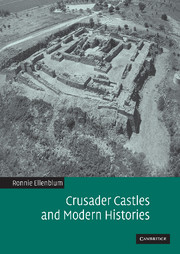Book contents
- Frontmatter
- Contents
- List of illustrations
- List of tables
- Acknowledgements
- Part I National discourse and the study of the Crusades
- 1 From moral failure to a source of pride
- 2 The narrative of the Crusades and the nationalist discourse
- 3 Nationalist discourse and Crusader archaeology
- Part II Crusader studies between colonialist and post-colonialist discourse
- Part III Geography of fear and the spatial distribution of Frankish castles
- Part IV The castle as dialogue between siege tactics and defence strategy
- Conclusion
- Appendix
- Bibliography
- Author index
- Subject index
3 - Nationalist discourse and Crusader archaeology
Published online by Cambridge University Press: 29 July 2009
- Frontmatter
- Contents
- List of illustrations
- List of tables
- Acknowledgements
- Part I National discourse and the study of the Crusades
- 1 From moral failure to a source of pride
- 2 The narrative of the Crusades and the nationalist discourse
- 3 Nationalist discourse and Crusader archaeology
- Part II Crusader studies between colonialist and post-colonialist discourse
- Part III Geography of fear and the spatial distribution of Frankish castles
- Part IV The castle as dialogue between siege tactics and defence strategy
- Conclusion
- Appendix
- Bibliography
- Author index
- Subject index
Summary
THE EXPROPRIATION OF CRUSADER ARCHAEOLOGY AND ARCHITECTURE BY GERMAN NATIONALISM
During the second half of the nineteenth century, the transformation of the story of the Crusades from a pan-European account into a national narrative, and from a resounding failure into a source of national pride, extended into the physical aspects of the Crusades as well. French scholars began to claim that not only were the expeditions an integral episode of French history, but that Crusader archaeological and architectural remains were proof that Frankish civilisation in the Levant was, in effect, an aspect of ‘French culture’. Though it is true that German scholars who followed in the footsteps of their French counterparts did not claim that the Crusades were ‘German’, they too harnessed the popularity of the Crusades and Crusader archaeology to the wagon of German nationalism.
‘Nationalisation’ of Crusader architecture was part of a more widespread process by which medieval physical remains became integral components of different, and parallel, national narratives. From the early nineteenth century, for example, the Romanesque and Gothic styles, which until the late eighteenth century were considered universal and ‘European’, began to serve as physical insignia of the various national movements. ‘Crusader architecture’ underwent a similar transformation.
The earliest attempts to link nationalist ideology with ‘national medieval architecture’ are to be found in German nationalist writings of the early nineteenth century, particularly the works of Catholic historian Josef von Görres (1776–1848) and his disciples.
Information
- Type
- Chapter
- Information
- Crusader Castles and Modern Histories , pp. 32 - 40Publisher: Cambridge University PressPrint publication year: 2007
